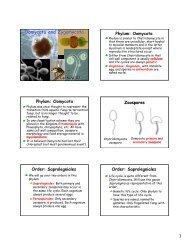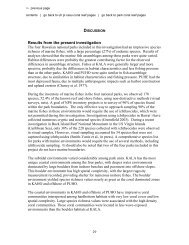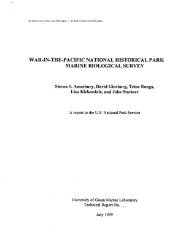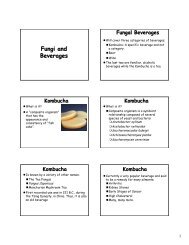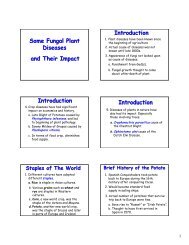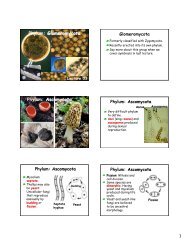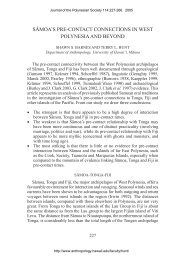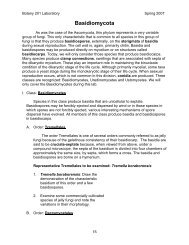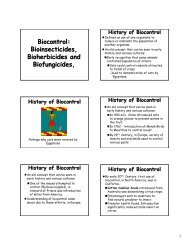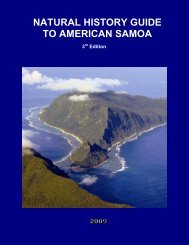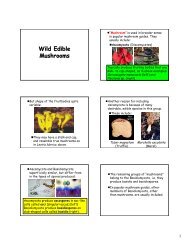american samoa - University of Hawaii at Manoa Botany Department
american samoa - University of Hawaii at Manoa Botany Department
american samoa - University of Hawaii at Manoa Botany Department
- No tags were found...
You also want an ePaper? Increase the reach of your titles
YUMPU automatically turns print PDFs into web optimized ePapers that Google loves.
WETLAND RESTORATION AND ENHANCEMENT STRATEGIESGeneralThere are two potential opportunities for the restor<strong>at</strong>ion and enhancement <strong>of</strong> Taufusi Marsh.The scope <strong>of</strong> these two opportunities and rel<strong>at</strong>ed implement<strong>at</strong>ion str<strong>at</strong>egies are presented in thefollowing paragraphs.The potential benefits and impacts derived from the implement<strong>at</strong>ion <strong>of</strong> each str<strong>at</strong>egy aresubsequently compared and evalu<strong>at</strong>ed. This analysis provides the basis for the selection <strong>of</strong> arecommended restor<strong>at</strong>ion or enhancement str<strong>at</strong>egy.Preliminary cost estim<strong>at</strong>es are presented for the implement<strong>at</strong>ion <strong>of</strong> the recommended str<strong>at</strong>egy.Long-term monitoring and site maintenance requirements associ<strong>at</strong>ed with the recommendedstr<strong>at</strong>egy are also identified.Altern<strong>at</strong>e Opportunities and Str<strong>at</strong>egiesOption 1: Restore N<strong>at</strong>ive Marsh Veget<strong>at</strong>ion and Wildlife Habit<strong>at</strong>This option would <strong>at</strong>tempt to restore n<strong>at</strong>ive marsh veget<strong>at</strong>ion in portions <strong>of</strong> the west part <strong>of</strong> theTaufusi Marsh. This restor<strong>at</strong>ion effort would be made through the planting <strong>of</strong> n<strong>at</strong>ive marshplants such as utuutu (w<strong>at</strong>er chestnut), vao tuaniu (marsh fern), and sa<strong>at</strong>o (swamp fern).Plantings <strong>of</strong> seedlings or cuttings would be obtained by the ASCC Land Grant program andplanted by program personnel in selected portions <strong>of</strong> west Taufusi Marsh. However, it shouldbe noted th<strong>at</strong> the feasibility <strong>of</strong> this option has not been tested through the propag<strong>at</strong>ion <strong>of</strong> theseplants in American Samoa or other parts <strong>of</strong> Polynesia (Whistler, 2000)Soil prepar<strong>at</strong>ion will likely include the clearing and/or excav<strong>at</strong>ion <strong>of</strong> some areas where denseexotic veget<strong>at</strong>ion is already established. Plant spacing and density would be determined by theASCC Land Grant Program prior to the initi<strong>at</strong>ion <strong>of</strong> planting.None <strong>of</strong> the recommended marsh plants were found in the marsh in November 1999 andprobably do not exist there. However, the establishment <strong>of</strong> these n<strong>at</strong>ive marsh plants wouldenhance the <strong>at</strong>tractiveness <strong>of</strong> this marsh to the toloa (Australian Gray Duck). This duck iswidespread in the South Pacific, but very rare in American Samoa. The habit<strong>at</strong> <strong>of</strong> theAustralian Gray Duck is typically fresh-w<strong>at</strong>er wetlands, but the duck is occasionally found inbrackish or salt w<strong>at</strong>er (Engbring and Ramsey, 1989). Occasional sightings <strong>of</strong> the AustralianGray Duck have been documented in the vicinity <strong>of</strong> nearby Maliuga Point (Aecos and Aqu<strong>at</strong>icFarms, 1980).Option 2: Restore Taro ProductionOption 2 (Figure 3-4) would restore taro production within the west portion <strong>of</strong> Taufusi Marsh.This potential restor<strong>at</strong>ion project would somewh<strong>at</strong> increase the capability <strong>of</strong> the marsh to detainstorm w<strong>at</strong>er. Increased detention would also promote gre<strong>at</strong>er recharge <strong>of</strong> surface run<strong>of</strong>f intothe basal aquifer.ASPA oper<strong>at</strong>es one groundw<strong>at</strong>er well (well 161) and a rel<strong>at</strong>ed s<strong>at</strong>ellite w<strong>at</strong>er system in Alao.Well 161 produced approxim<strong>at</strong>ely 12,000 gallons per day in May 2000. Consequently, thepotential benefits <strong>of</strong> increased groundw<strong>at</strong>er recharge provide a feasible opportunity to conservepotable w<strong>at</strong>er supplies in Alao.American Samoa Wetland/Stream Restor<strong>at</strong>ion and Enhancement PlanFebruary 2001, Alao Wetland, Page 3-9



